Q9. In Fig, ABCD is a rectangle with dimensions 32 m by 18 m. ADE is a triangle such that EF ⊥ AD and EF=14 m. Calculate the area of the shaded region.

Sol.
We know that area of the rectangle ABCD = Length × Breadth
\begin{array}{l} =AB \times BC =32 \times 18 =576 \text { m}^{2} \\\text {Area of the triangle DEA } =\frac{1}{2} \times \text {Base} \times \text {Altitude} \\ =\frac{1}{2} \times \text {AD} \times \text {EF} \\ =\frac{1}{2} \times 18 \times 14 \\ =126 \text { m}^{2} \\\therefore \text {Area of the shaded region } = \text {Area of the rectangle} – \text {Area of the triangle } \\ =576-126 =450 \text { m}^{2}\end{array}Q10. In Fig., ABCD is a rectangle of length AB=40 cm and breadth BC=25 cm. If P, Q, R, S be the mid-points of the sides AB, BC, D and DA respectively, find the area of the shaded region.

Sol.
Given ABCD is a rectangle of length AB=40 cm and breadth BC=25 cm.
Area of the rectangle ABCD = Length × Breadth
\begin{array}{l} =AB \times BC =40 \times 25 =1000 \text { cm}^{2} \\\text {SQ and PR the diagonals of quadrilateral PQRS} \\ \text {Also } AB = SQ = AB = 40 \text { cm} \\ \text {And } BC = PR = AB = 25 \text { cm} \\\text {Area of the quadrilateral PQRS } =\frac{1}{2}(\text { Product of diagonals }) \\=\frac{1}{2}(40 \times 25) =500 \text { cm}^{2} \\\therefore \text {Area of the shaded region } =\text { Area of rectangle ABCD } – \text {Area of quadrilateral PQRS} \\ =1000 -500 = 500\text { cm}^{2} \\\end{array}Q11. Calculate the area of the quadrilateral ABCD as shown in Fig., given that BD=42 cm, AC=28 cm, AC=28 cm, OD=12 cm and } AC ⊥ BD

Sol.
Given that BD =42 cm, AC=28 cm, OD=12 cm.
\begin{array}{l} \Rightarrow \quad BO = BD – OD = 42 – 12 = 30 \text { cm} \\\text {Area of Triangle ABC } =\frac {1}{2} \times AC \times BO \\ =\frac {1}{2} \times 28 \times 30 \\ =14 \times 30 \\ =420 \text { cm}^{2} \\\text {Area of Triangle ADC } =\frac {1}{2} \times AC \times OD \\ =\frac {1}{2} \times 28 \times 12 \\ =14 \times 12 \\ =168 \text { cm}^{2} \\\text {Hence, Area of the quadrilateral ABCD } \\ = \text {Area of Triangle ABC } + \text {Area of Triangle ADC } \\ =(420+168)\text { cm}^{2} \\ =588 \text { cm}^{2} \\ \\ \end{array}Q12. Find the area of a figure formed by a square of side 8 cm and an isosceles triangle with base as one side of the square and perimeter as 18 cm.
Sol.

Given that the perimeter of the isosceles triangle ADE =18 cm.
ADE is an isoceles triangle so AE = ED
Also, ABCD is an square having side as 8 cm.
\begin{array}{l} \Rightarrow \quad AD + AE + ED = 18 \\ \Rightarrow \quad 8 + AE + AE = 18 \\ \Rightarrow \quad 2AE = 18 -8\\ \Rightarrow \quad AE = \frac {10}{2} = 5 \text { cm}= ED \\ \text {Area of square ABCD} = (Side)^{2} = 8^{2} = 64 \text { cm}^{2} \\ \text {Area of isosceles triangle ADE} = \frac{1}{2}(\text { Base }) \times \sqrt{(\text {equalside})^{2}-\frac{1}{4} \times(\text {base})^{2}} \\ =\frac{1}{2} \times 8 \times \sqrt{(5)^{2}-\frac{1}{4} \times(8)^{2}} \\ =4 \times \sqrt{25-16} \\ =4 \times \sqrt{9} \\ =4 \times 3 \\ =12 \text { cm}^{2} \\\text {Required area of the figure formed } \\ = \text {Area of the square ABCD} + \text {Area of the isosceles triangle ADE } \\ = 64 +12 = 76 \text { cm}^{2} \\\end{array}Q13. Find the area of Fig. in the following ways:
(i) Sum of the areas of three triangles.
(ii) Area of a rectangle – Sum of the areas of three triangles

Sol.
(i) P is the midpoint of AD. Thus AP=PD=25 cm and AB=DC=20 cm.
Using the figure, Area of triangle APB = Area of triangle PDC
\begin{array}{l} \text {Area of triangle APB } =\frac{1}{2} \times AB \times AP \\ =\frac{1}{2} \times 20 \times 25=250 \text { cm}^{2} \\\text {Area of triangle PDC}= \text {Area of triangle APB } =\text { cm}^{2} \\ \text {Area of triangle RPQ}=\frac{1}{2} \times \text {Base } \times \text {Height} \\ =\frac{1}{2} \times 25 \times 10 =125 \text { cm}^{2} \\\text {Hence, Sum of the three triangles }=(250+250+125) \text { cm}^{2} =625 \text { cm}^{2} \\ \\\text {(ii) Area of the rectangle ABCD} =50 \times 20 =1000 \text { cm}^{2} \\ \therefore \text {Area of the rectangle}- \text {Sum of the areas of three triangles} \\ =1000 – 625=375 \text { cm}^{2} \\\end{array}Q14. Calculate the area of quadrilateral field ABCD as shown in Fig., by dividing it into a rectangle and a triangle.

Sol.
Draw a line CE parallel to AB, so that it intersect AD at point E.
\begin{array}{l} \text {Given that } AB=30 \text { m} \Rightarrow \quad EC= AB=30 \text { m} \\ \text {Given that } BC=25 \text { m} \Rightarrow \quad AE= BC=25 \text { m} \\ \Rightarrow \quad ED = AD – AE = 50 -25 = 25 \text { m} \\\text {Area of rectangle ABCE } = \text {Length} \times \text {Breadth} \\ =AB \times BC =30 \times 25 =750 \text { m}^{2} \\\text {Area of triangle CED } =\frac {1}{2} \times ED \times ED \\=\frac {1}{2} \times 25 \times 30 \\ =375 \text { m}^{2} \\ \text {Hence, Area of the quadrilateral ABCD } \\ =\text {Area of rectangle ABCE } + \text {Area of triangle CED } \\ =(750+375) \text { m}^{2} \\ =1125 \text { m}^{2} \\ \end{array}Q15. Calculate the area of the pentagon ABCDE, where AB=AE and with dimensions as shown in Fig.

Sol.
Area of the rectangle BCDE = BC × CD. \begin{array}{l} =(10 \times 12) \text { cm}^{2} \\ =120 \text { cm}^{2} \\ \text {Area of triangle ABE } =\frac{1}{2} \times \text {Base} \times \text { Height} \\ =\frac{1}{2} \times BE \times AF \\ =\frac{1}{2} \times 10 \times (20-12) \text { cm}^{2} \\ =\frac{1}{2} \times 10 \times 8 \text { cm}^{2} \\ =40 \text { cm}^{2} \\ \text {Hence, Area of the pentagon ABCDE } =120 + 40=160 \text { cm}^{2} \\\end{array}Q16. The base of a triangular field is three times its altitude. If the cost of cultivating the field at Rs 24.60 per hectare is Rs. 332.10, find its base and height.
Sol.
 Let’s assume that altitude of the triangular field be h m.
Let’s assume that altitude of the triangular field be h m.
Then base of the triangular field is 3h m.
\begin{array}{l} \text {Area of the triangular field } =\frac{1}{2} \times h \times 3 h \\ =\frac{3 h^{2}}{2} \text { m}^{2} \ldots \ldots \ldots \ldots (i) \\\text {Given rate of cultivating the field is Rs. 24.60 per hectare. and total cost of cultivating is Rs. 332.10} \\ \therefore \text {Area of the triangular field } = \frac {\text {Total Cost}}{\text {Rate per hectare}} \\ =\frac{332.10}{24.60} \text { hectare} \\ =13.5 \text { hectare} \\ =13.5 \times 10000 \text { m}^{2} \quad \quad [\because 1 \text { hectare} =10000 \text { m}^{2} ] \\ =135000 \text { m}^{2} \ldots \ldots \ldots \ldots (ii) \\ \text {From equation (i) and (ii) we have } \\ \frac{3 h^{2}}{2}=135000 \\ \Rightarrow \quad h^{2}=\frac {135000 \times 2}{3} \\ \Rightarrow \quad h^{2}=90000 \ \\ \Rightarrow \quad h=\sqrt {90000} \ \\ \Rightarrow \quad h=\sqrt {300 \times 300} \\ \Rightarrow \quad h=300 \text { m} \\ \end{array} Hence, Height of the triangular field is 300 m.
And base of the triangular field = 3 × 300= 900 m.
Q17. A wall is 4.5 m long and 3 m high. It has two equal windows, each having form and dimensions as shown in Fig. Find the cost of painting the wall (leaving windows) at the rate of Rs. 15 per sq m.

Sol.
Length of a wall = 4.5 m
Breadth of the wall = 3 m
Area of the wall = Length × Breadth
\begin{array}{l} =4.5 \times 3 =13.5 \text { m}^{2} \\\text {Area of the rectangle BCDE} = \text {Lenght} \times \text {Breadth} \\ = 80 \times 50 = 4000 \text { cm}^{2} \\ = 4000 \times \frac{1}{10000} \text { m}^{2} \quad \quad [\because 1 \text { cm}^{2} =\frac{1}{10000} \text { m}^{2} ] \\ = 0.4 \text { m}^{2} \\\text {Area of the triangle ABE} = \frac {1}{2} \times \text {Base} \times {Altitude} \\ = \frac {1}{2} \times 80 \times 20 \text { cm}^{2} \\ = \frac {1}{2} \times 80 \times 20 \frac{1}{10000} \text { m}^{2} \quad \quad [\because 1 \text { cm}^{2} =\frac{1}{10000} \text { m}^{2} ] \\ = 0.08 \text { m}^{2} \\\text {As per given figure, Area of the window } \\ = \text {Area of the rectangle BCDE} + \text {Area of the triangle ABE} \\=(0.4 + 0.08) \text { m}^{2} \\ =0.48 \text { m}^{2} \\ \text {Area of 2 windows } =2 \times 0.48 = 0.96 \text { m}^{2} \\\text {Area of the remaining wall without windows} \\ = \text {Area of the wall } – \text {Area of 2 windows } \\ =(13.5 – 0.96) \text { m}^{2} \\ =12.54 \text { m}^{2} \\\text {Rate of painting is Rs. 15 per } m^{2} \\ \therefore \text {The cost of painting on the wall } =\text{Rs. } 15 \times 12.54 =\text{Rs. } 188.1 \end{array}
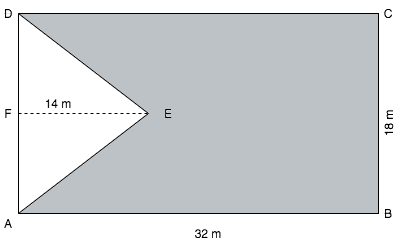
Sol.
We know that area of the rectangle ABCD = Length × Breadth
\begin{array}{l} =AB \times BC =32 \times 18 =576 \text { m}^{2} \\\text {Area of the triangle DEA } =\frac{1}{2} \times \text {Base} \times \text {Altitude} \\ =\frac{1}{2} \times \text {AD} \times \text {EF} \\ =\frac{1}{2} \times 18 \times 14 \\ =126 \text { m}^{2} \\\therefore \text {Area of the shaded region } = \text {Area of the rectangle} – \text {Area of the triangle } \\ =576-126 =450 \text { m}^{2}\end{array}Q10. In Fig., ABCD is a rectangle of length AB=40 cm and breadth BC=25 cm. If P, Q, R, S be the mid-points of the sides AB, BC, D and DA respectively, find the area of the shaded region.

Sol.
Given ABCD is a rectangle of length AB=40 cm and breadth BC=25 cm.
Area of the rectangle ABCD = Length × Breadth
\begin{array}{l} =AB \times BC =40 \times 25 =1000 \text { cm}^{2} \\\text {SQ and PR the diagonals of quadrilateral PQRS} \\ \text {Also } AB = SQ = AB = 40 \text { cm} \\ \text {And } BC = PR = AB = 25 \text { cm} \\\text {Area of the quadrilateral PQRS } =\frac{1}{2}(\text { Product of diagonals }) \\=\frac{1}{2}(40 \times 25) =500 \text { cm}^{2} \\\therefore \text {Area of the shaded region } =\text { Area of rectangle ABCD } – \text {Area of quadrilateral PQRS} \\ =1000 -500 = 500\text { cm}^{2} \\\end{array}Q11. Calculate the area of the quadrilateral ABCD as shown in Fig., given that BD=42 cm, AC=28 cm, AC=28 cm, OD=12 cm and } AC ⊥ BD
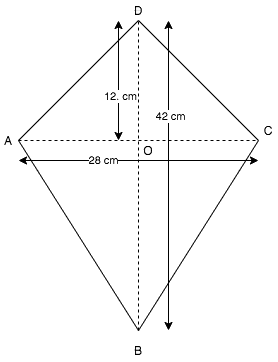
Sol.
Given that BD =42 cm, AC=28 cm, OD=12 cm.
\begin{array}{l} \Rightarrow \quad BO = BD – OD = 42 – 12 = 30 \text { cm} \\\text {Area of Triangle ABC } =\frac {1}{2} \times AC \times BO \\ =\frac {1}{2} \times 28 \times 30 \\ =14 \times 30 \\ =420 \text { cm}^{2} \\\text {Area of Triangle ADC } =\frac {1}{2} \times AC \times OD \\ =\frac {1}{2} \times 28 \times 12 \\ =14 \times 12 \\ =168 \text { cm}^{2} \\\text {Hence, Area of the quadrilateral ABCD } \\ = \text {Area of Triangle ABC } + \text {Area of Triangle ADC } \\ =(420+168)\text { cm}^{2} \\ =588 \text { cm}^{2} \\ \\ \end{array}Q12. Find the area of a figure formed by a square of side 8 cm and an isosceles triangle with base as one side of the square and perimeter as 18 cm.
Sol.
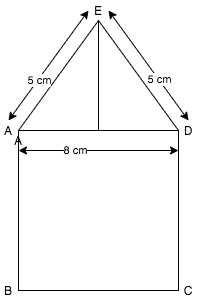
Given that the perimeter of the isosceles triangle ADE =18 cm.
ADE is an isoceles triangle so AE = ED
Also, ABCD is an square having side as 8 cm.
\begin{array}{l} \Rightarrow \quad AD + AE + ED = 18 \\ \Rightarrow \quad 8 + AE + AE = 18 \\ \Rightarrow \quad 2AE = 18 -8\\ \Rightarrow \quad AE = \frac {10}{2} = 5 \text { cm}= ED \\ \text {Area of square ABCD} = (Side)^{2} = 8^{2} = 64 \text { cm}^{2} \\ \text {Area of isosceles triangle ADE} = \frac{1}{2}(\text { Base }) \times \sqrt{(\text {equalside})^{2}-\frac{1}{4} \times(\text {base})^{2}} \\ =\frac{1}{2} \times 8 \times \sqrt{(5)^{2}-\frac{1}{4} \times(8)^{2}} \\ =4 \times \sqrt{25-16} \\ =4 \times \sqrt{9} \\ =4 \times 3 \\ =12 \text { cm}^{2} \\\text {Required area of the figure formed } \\ = \text {Area of the square ABCD} + \text {Area of the isosceles triangle ADE } \\ = 64 +12 = 76 \text { cm}^{2} \\\end{array}Q13. Find the area of Fig. in the following ways:
(i) Sum of the areas of three triangles.
(ii) Area of a rectangle – Sum of the areas of three triangles
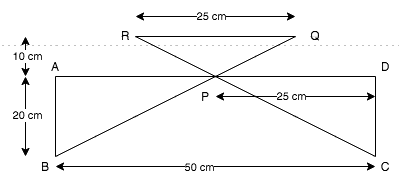
Sol.
(i) P is the midpoint of AD. Thus AP=PD=25 cm and AB=DC=20 cm.
Using the figure, Area of triangle APB = Area of triangle PDC
\begin{array}{l} \text {Area of triangle APB } =\frac{1}{2} \times AB \times AP \\ =\frac{1}{2} \times 20 \times 25=250 \text { cm}^{2} \\\text {Area of triangle PDC}= \text {Area of triangle APB } =\text { cm}^{2} \\ \text {Area of triangle RPQ}=\frac{1}{2} \times \text {Base } \times \text {Height} \\ =\frac{1}{2} \times 25 \times 10 =125 \text { cm}^{2} \\\text {Hence, Sum of the three triangles }=(250+250+125) \text { cm}^{2} =625 \text { cm}^{2} \\ \\\text {(ii) Area of the rectangle ABCD} =50 \times 20 =1000 \text { cm}^{2} \\ \therefore \text {Area of the rectangle}- \text {Sum of the areas of three triangles} \\ =1000 – 625=375 \text { cm}^{2} \\\end{array}Q14. Calculate the area of quadrilateral field ABCD as shown in Fig., by dividing it into a rectangle and a triangle.

Sol.
Draw a line CE parallel to AB, so that it intersect AD at point E.
\begin{array}{l} \text {Given that } AB=30 \text { m} \Rightarrow \quad EC= AB=30 \text { m} \\ \text {Given that } BC=25 \text { m} \Rightarrow \quad AE= BC=25 \text { m} \\ \Rightarrow \quad ED = AD – AE = 50 -25 = 25 \text { m} \\\text {Area of rectangle ABCE } = \text {Length} \times \text {Breadth} \\ =AB \times BC =30 \times 25 =750 \text { m}^{2} \\\text {Area of triangle CED } =\frac {1}{2} \times ED \times ED \\=\frac {1}{2} \times 25 \times 30 \\ =375 \text { m}^{2} \\ \text {Hence, Area of the quadrilateral ABCD } \\ =\text {Area of rectangle ABCE } + \text {Area of triangle CED } \\ =(750+375) \text { m}^{2} \\ =1125 \text { m}^{2} \\ \end{array}Q15. Calculate the area of the pentagon ABCDE, where AB=AE and with dimensions as shown in Fig.

Sol.
Area of the rectangle BCDE = BC × CD. \begin{array}{l} =(10 \times 12) \text { cm}^{2} \\ =120 \text { cm}^{2} \\ \text {Area of triangle ABE } =\frac{1}{2} \times \text {Base} \times \text { Height} \\ =\frac{1}{2} \times BE \times AF \\ =\frac{1}{2} \times 10 \times (20-12) \text { cm}^{2} \\ =\frac{1}{2} \times 10 \times 8 \text { cm}^{2} \\ =40 \text { cm}^{2} \\ \text {Hence, Area of the pentagon ABCDE } =120 + 40=160 \text { cm}^{2} \\\end{array}Q16. The base of a triangular field is three times its altitude. If the cost of cultivating the field at Rs 24.60 per hectare is Rs. 332.10, find its base and height.
Sol.
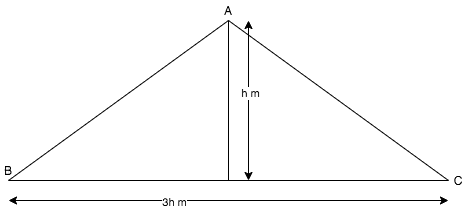 Let’s assume that altitude of the triangular field be h m.
Let’s assume that altitude of the triangular field be h m. Then base of the triangular field is 3h m.
\begin{array}{l} \text {Area of the triangular field } =\frac{1}{2} \times h \times 3 h \\ =\frac{3 h^{2}}{2} \text { m}^{2} \ldots \ldots \ldots \ldots (i) \\\text {Given rate of cultivating the field is Rs. 24.60 per hectare. and total cost of cultivating is Rs. 332.10} \\ \therefore \text {Area of the triangular field } = \frac {\text {Total Cost}}{\text {Rate per hectare}} \\ =\frac{332.10}{24.60} \text { hectare} \\ =13.5 \text { hectare} \\ =13.5 \times 10000 \text { m}^{2} \quad \quad [\because 1 \text { hectare} =10000 \text { m}^{2} ] \\ =135000 \text { m}^{2} \ldots \ldots \ldots \ldots (ii) \\ \text {From equation (i) and (ii) we have } \\ \frac{3 h^{2}}{2}=135000 \\ \Rightarrow \quad h^{2}=\frac {135000 \times 2}{3} \\ \Rightarrow \quad h^{2}=90000 \ \\ \Rightarrow \quad h=\sqrt {90000} \ \\ \Rightarrow \quad h=\sqrt {300 \times 300} \\ \Rightarrow \quad h=300 \text { m} \\ \end{array} Hence, Height of the triangular field is 300 m.
And base of the triangular field = 3 × 300= 900 m.
Q17. A wall is 4.5 m long and 3 m high. It has two equal windows, each having form and dimensions as shown in Fig. Find the cost of painting the wall (leaving windows) at the rate of Rs. 15 per sq m.
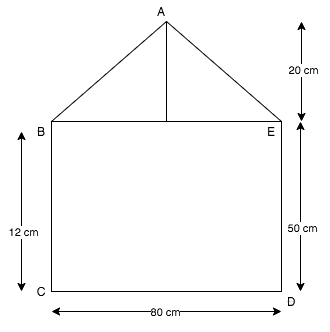
Sol.
Length of a wall = 4.5 m
Breadth of the wall = 3 m
Area of the wall = Length × Breadth
\begin{array}{l} =4.5 \times 3 =13.5 \text { m}^{2} \\\text {Area of the rectangle BCDE} = \text {Lenght} \times \text {Breadth} \\ = 80 \times 50 = 4000 \text { cm}^{2} \\ = 4000 \times \frac{1}{10000} \text { m}^{2} \quad \quad [\because 1 \text { cm}^{2} =\frac{1}{10000} \text { m}^{2} ] \\ = 0.4 \text { m}^{2} \\\text {Area of the triangle ABE} = \frac {1}{2} \times \text {Base} \times {Altitude} \\ = \frac {1}{2} \times 80 \times 20 \text { cm}^{2} \\ = \frac {1}{2} \times 80 \times 20 \frac{1}{10000} \text { m}^{2} \quad \quad [\because 1 \text { cm}^{2} =\frac{1}{10000} \text { m}^{2} ] \\ = 0.08 \text { m}^{2} \\\text {As per given figure, Area of the window } \\ = \text {Area of the rectangle BCDE} + \text {Area of the triangle ABE} \\=(0.4 + 0.08) \text { m}^{2} \\ =0.48 \text { m}^{2} \\ \text {Area of 2 windows } =2 \times 0.48 = 0.96 \text { m}^{2} \\\text {Area of the remaining wall without windows} \\ = \text {Area of the wall } – \text {Area of 2 windows } \\ =(13.5 – 0.96) \text { m}^{2} \\ =12.54 \text { m}^{2} \\\text {Rate of painting is Rs. 15 per } m^{2} \\ \therefore \text {The cost of painting on the wall } =\text{Rs. } 15 \times 12.54 =\text{Rs. } 188.1 \end{array}
